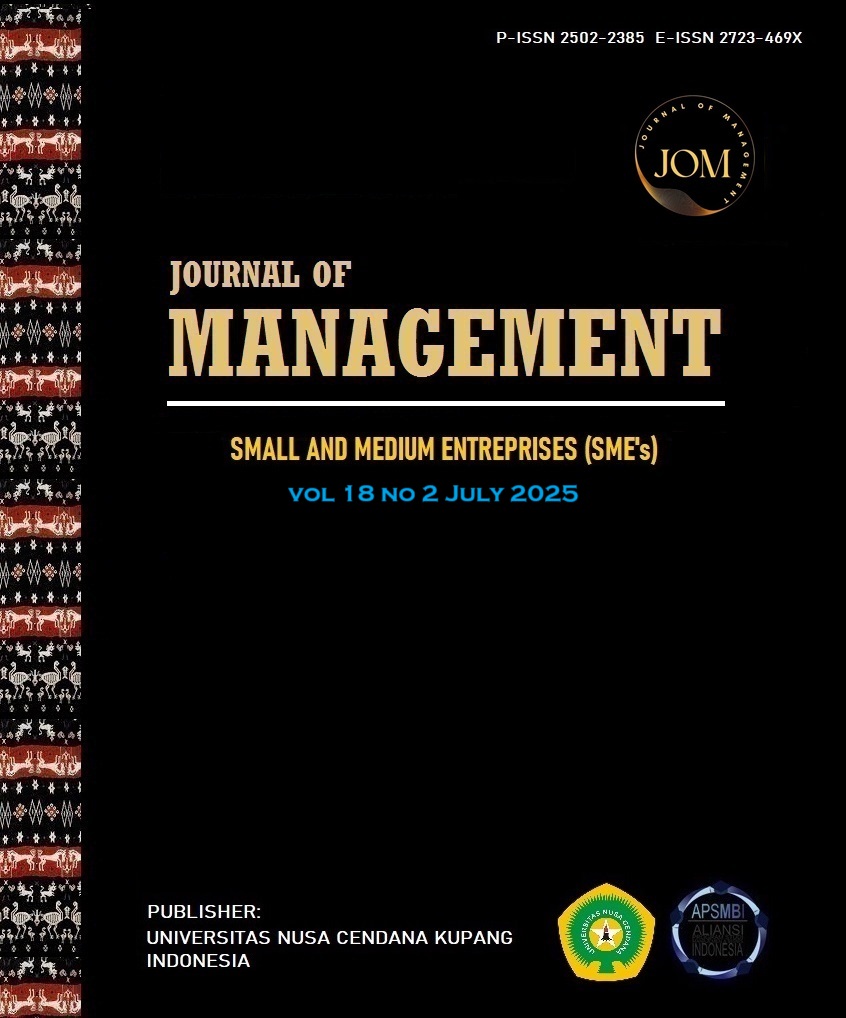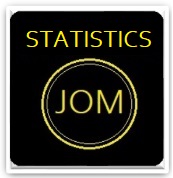THE INFLUENCE OF PERCEIVED BENEFITS AND TRUST ON INTEREST IN USING E-WALLET DANA IN KUPANG CITY
Abstract
This research was conducted on DANA e-wallet users in Kupang City. This study aims to determine and analyze, both partially and simultaneously, the effect of perceived usefulness and trust on intention to use the e-wallet DANA in Kupang City. This study uses perceived usefulness and trust as independent variables and usage intention as the dependent variable. The number of samples was 100 respondents, with the sampling technique used being purposive sampling. Data collection was carried out using questionnaires, interviews, and literature studies. The data analysis technique used is quantitative descriptive analysis, multiple linear regression analysis, and hypothesis testing through the t-test, F-test, and analysis of the coefficient of determination (R²) using the SPSS 23 application. The results of the descriptive analysis show that overall respondents gave a very good perception assessment of perceived usefulness and trust. The results of the t-test and F-test show that partially perceived usefulness and trust have a significant effect on intention to use. Based on the adjusted R² value, the contribution of the perceived usefulness and trust variables to intention to use is 68.5%. While the remaining 31.5% of the Usage Intention variable is influenced by other variables not discussed in this study, such as risk perception, service features, and level of understanding. For this reason, it is suggested that further researchers can further examine variables outside of this study that can influence intention to use, and not only on DANA e-wallet but also on other types of e-wallets, such as OVO, Gopay, and Shopee Pay.
Keywords: Perceived Benefits; Trust; Intention to Use
Downloads
References
Atriani., et al (2020). Pengaruh Persepsi Manfaat dan Kemudahan Penggunaan Terhadap Minat Menggunakan Dompet Digital OVO.Jurnal Sosial Ekonomi dan Humaniora. Vol. 6 No. 1: 56-61.
Bailey, A., et al. (2017). Mobile payments adoption by US consumers: an extended TAM. International Journal of Retail & Distribution Management, Vol. 45 Issue: 6.
BI Institute. (2023). Dompet Digital Naik Daun, Membetot Minat Kala Pandemi. https://www.bi.go.id/id/bi-institute/BI-Epsilon/Pages/Dompet-Digital--Naik-Daun,-Membetot-Minat-Kala-Pandemi.aspx. Accessed on 18 Juli 2023.
Davis, F. D. (1989). “Perceived Usefulness, Perceived Ease of Use, and User Acceptance of Information Technology” MIS Quarterly. Vol. 13 No.3, 319-340.
Fullah, L & Chandra, S. (2012).Pengaruh Persepsi Manfaat, Kemudahan Penggunaan, Resiko, dan Kepercayaan Terhadap Minat Nasabah dalam Menggunakan Internet Banking BRI (Studi Kasus: Seluruh Nasabah Bank BRI Jakarta).School & Business Management. Universitas Bina Nusantara.
Hasya, R (2022). Ini 10 E-Wallet yang Paling Sering Dipakai Masyarakat Indonesia Tahun 2022 https://goodstats.id/article/ini-10-e-wallet-yang-paling sering-dipakai-masyarakat-indonesia-M4TA4 Accessed on August 20th 2023.
Jange, B., et al. (2024). Peran Teknologi Finansial (Fintech) dalam Transformasi Layanan Keuangan di Indonesia. IRJE : Indonesian Research Journal on Education, Vol.4 No.3, 1199-1205.
Jugiyanto, H. M. (2007). “Sistem Informasi Keperilakuan”. Yogyakarta: Andi Offset. (2019). Teori Portofolio dan Analisis Investasi. Edisi Kelima.Yogyakarta: Bpfe.
Kawitan, F. P & Sulistyawati, L. (2021). Analisis Technology Acceptance Model (TAM) pada Penggunaan Finance Technology “Dana”. JABEISTIK: Jurnal Analitika Bisnis, Ekonomi, Sosial dan Politik, Vol.1 No.2, 148-158.
Kesuma, P & Nurbaiti (2023). Minat Menggunakan E-Wallet Dana di Kalangan Mahasiswa di Kota Medan. Jurnal Ekonomi & Ekonomi Syariah.Vol. 6 No.1.
Khoirunnisa. (2019). iPrice: Top 10 E-wallet di Indonesia Q2-2019. https://selular.id/2019/08/iprice-top-10-e-wallet-di-indonesia-q2-2019/. Accessed on August 18th 2023.
Kotler, P., & Keller, K. L. (2016). Manajemen Pemasaran. Jakarta: Penerbit Erlangga.
Kumala, D. C., et al. (2020). Pengaruh Perceived Usefulness, Perceived Ease of Use, Trust, dan Security Terhadap Minat Penggunaan Gopay Pada Generasi X di Surabaya. Jurnal Manajemen Perhotelan. Vol. 6, No.1: 19-29.
Kurniawan, A., et al. (2022). The Effect of Perceived of Ease of Use, Perceived of Benefits, Trust, Perceived of Risk and Level of Understanding of Electronic Money on Interest in Using E-Money. Accounting Research Journal of Sutaatmadja.Vol. 6 No.1: 132-153.
Melasari, C., et al (2018). Pengaruh Kepercayaan, Kegunaan, Kemudahan, Privacy Risk, Time Risk, dan Financial Risk Terhadap Minat Penggunaan Mobile Banking Bank Muamalat. Vol. 25 No. 1: 11-23.
Portal Informasi Indonesia (2023). transaksi Uang Elektronik Melejit https://www.indonesia.go.id/kategori/indonesia-dalam-angka/6855/transaksi-uang-elektronik-melejit?lang=1. Accessed on August 20th 2023.
Pratama, A. B & Suputra, I. D. G. D. (2019). Pengaruh Persepsi Manfaat, Persepsi Kemudahan Penggunaan, dan Tingkat Kepercayaan Pada Minat Menggunakan Uang Elektronik. E-Jurnal Akuntansi Universitas Udayana. Vol.27 No. 2: 927-953.
Priansa, D. J. (2017). Perilaku Konsumen: Dalam Persaingan Bisnis Kontemporer. Bandung: Alfabeta.
Rahmida. (2021). Technology Acceptance Model (TAM) Approach in Analyzing Mobile Banking Usage in Millennial Generation. HUMANIS. Vol.2 No.1,181-189.
Rodiah, S & Melati, I. S (2020). Pengaruh kemudahan Penggunaan, Kemanfaatan, Resiko, dan Kepercayaan terhadap Minat Menggunakan E-wallet pada Generasi Milenial Kota Semarang. Journal of Economic Education and Entrepreneurship Vol. 1(2) (2020) 66-80.
Sugiyono, (2011). Metode Penelitian Kuantitatif, Kualitatif, dan Kombinasi (Mixed Methods) Bandung: Alfabeta.
Teo, T. 2011. Technology Acceptance in Education: Research and Issues, Netherlands: Sence Publisher.
Venkatesh, V., & Davis, F.D. (2000). A Theoretical Extension of the Technology Acceptance Model: Four Longitudinal Field Studies. Management Science, Vol. 46, No. 2.
Widiyanti, W. (2020). Pengaruh Kemanfaatan, Kemudahan Penggunaan dan Promosi terhadap Keputusan Penggunaan E-wallet OVO di Depok. Jurnal Akuntansi dan Keuangan Vol. 7 No.1.
Yeo, S.F., et al. (2022). E-Wallet: A Study on Cashless Transactions Among University Students. (https://doi.org/10.12688/f1000research.73545.1). Accessed on August 20th 2023.

 Juita Lubrina Domina Bessie(1*)
Juita Lubrina Domina Bessie(1*)



